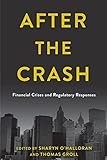After the Crash : Financial Crises and Regulatory Responses / ed. by Thomas Groll, Sharyn O'Halloran.
Material type: TextPublisher: New York, NY : Columbia University Press, [2019]Copyright date: ©2019Description: 1 online resourceContent type:
TextPublisher: New York, NY : Columbia University Press, [2019]Copyright date: ©2019Description: 1 online resourceContent type: - 9780231192842
- 9780231549998
- 330.9/0511 23
- HB3717 2008 .T435 2019
- online - DeGruyter
- Issued also in print.
| Item type | Current library | Call number | URL | Status | Notes | Barcode | |
|---|---|---|---|---|---|---|---|
 eBook
eBook
|
Biblioteca "Angelicum" Pont. Univ. S.Tommaso d'Aquino Nuvola online | online - DeGruyter (Browse shelf(Opens below)) | Online access | Not for loan (Accesso limitato) | Accesso per gli utenti autorizzati / Access for authorized users | (dgr)9780231549998 |
Frontmatter -- CONTENTS -- FOREWORD -- PREFACE -- 1. Introduction: Overview of the Financial Crisis and Its Impacts -- PART I. THE FINANCIAL CRISIS IN PERSPECTIVE -- 2. If "It" Happened Again: A Road Map for Regulatory Reform -- 3. Trends and Delegation in U.S. Financial Market Regulation -- 4. We Did Not Repeat the Errors of the Past: Lessons Drawn from the Fed's Policy During the Great Depression -- 5. Regulation and Competition in the EU Financial Sector -- 6. Trends in Financial Market Regulation -- PART II. CREATING THE RIGHT (DIS)INCENTIVES -- 7. Progress and Challenges After the Financial Crisis -- 8. Banks and Tax Havens: First Evidence Based on Country-by-Country Reporting -- 9. "Dynamic Precaution" in Maintaining Financial Stability: The Importance of FSOC -- PART III. USE AND (AB)USE OF MODELS IN PREDICTING FINANCIAL OUTCOMES -- 10. Reflections on the Global Financial Crisis Ten Years On -- 11. The Right Way to Use Models -- 12. The Fundamental Volatility of the Digital Economy as a Contributor to Financial Instability -- 13. The Impact of Regulation on Systemic Risk -- 14. Big Data, Process Scalability, and Financial Stability -- PART IV. REGULATING FOR THE NEXT CRISIS? -- 15. Rules Versus Principles in Financial Regulation Following the Crisis: It All Depends on the Purpose -- 16. How to Regulate in Times of Crisis -- 17. The Economic and Political Implications of the Dodd-Frank Act -- 18. The Regulatory Sine Curve: What Explains the Retreat from Systemic Risk Regulation (and Why It Was Predictable) -- 19. Roundtable: It's Not Too Much or Too Little Regulation; It's Getting It Right -- PART V. THE ORIGINS OF THE NEXT FINANCIAL CRISIS -- 20. Interview: Striking the Right Balance between Markets and Regulation -- 21. Money Market Funds After the Onset of the Crisis -- 22. The 2017 Tax Act's Potential Impact on Bank Safety and Capitalization -- 23. Derivative Clearinghouses: Collateral Management and Policy Implications -- Concluding Remarks -- CONTRIBUTORS -- INDEX
restricted access online access with authorization star
http://purl.org/coar/access_right/c_16ec
The 2008 financial crash was the worst financial crisis and the most severe economic downturn since the Great Depression. It triggered a complete overhaul of the global regulatory environment, ushering in a stream of new rules and laws to combat the perceived weakness of the financial system. While the global economy came back from the brink, the continuing effects of the crisis include increasing economic inequality and political polarization.Ten Years After the Crash is an innovative analysis of the crisis and its ongoing influence on the global regulatory, financial, and political landscape, with timely discussions of the key issues for our economic future. It brings together a range of expert and practitioner perspectives, including the Nobel Prize winner Joseph Stiglitz, the former congressman Barney Frank, the former treasury secretary Jacob Lew, the former deputy governor of the Bank of England Paul Tucker, and Steve Cutler, general counsel of JP Morgan Chase during the financial crisis. Each poses crucial questions: What were the origins of the crisis? How effective were international and domestic regulatory responses? Have we addressed the roots of the crisis through reform and regulation? Are our financial systems and the global economy better able to withstand another crash? Ten Years After the Crash is vital reading as both a retrospective on the last crisis and analysis of possible sources of the next one.
Issued also in print.
Mode of access: Internet via World Wide Web.
In English.
Description based on online resource; title from PDF title page (publisher's Web site, viewed 02. Mrz 2022)


